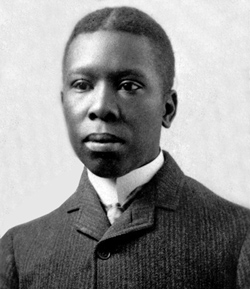Born: June 27, 1872
Died: February 9, 1906
Ohio connection: Birth
Dayton
Writer, poet, and lyricist, Paul Laurence Dunbar was born in Dayton, Ohio, on June 27, 1872. Dunbar, the son of Matilda Murphy Dunbar and Joshua Dunbar (who served in the 55th Massachusetts Infantry Regiment), two formerly enslaved people, wrote his first poem at the age of six. He showed literary promise in high school, where he was the only Black student in his class at Dayton’s Central High School. Dunbar’s talents shone at Central as he became editor of the school newspaper, was a debate club member, and was elected president of the literary society. Several of his poems appeared in the Dayton Herald as early as 1888 and, before graduating, he edited the Dayton Tattler, a weekly newspaper whose target audience was the African-American community of west Dayton. The Dayton Tattler was printed by Dunbar’s high school classmate Orville Wright; it ceased publication in 1890. After graduating high school in 1891, Dunbar had hopes of attending college or obtaining work as a journalist. He aspired to study law at Harvard University, but his widowed mother could not afford college tuition. Dunbar sought employment at Dayton newspapers and other businesses only to be rejected. He settled for work as an elevator operator, a job that proved conducive to his writing.
Dunbar’s first collection of poems, Oak and Ivy, was published in 1893. Both it and his next work, Majors and Minors (1896), feature poems written in both in the dialect reflective of Black life, and in Standard English. He is credited as the first writer to put the African American experience in all its diverse forms before a broader audience. Dunbar’s work which consists of novels, short stories, essays, and lyrics for Broadway musicals. Lyrics of Lowly Life (1896) became a best-selling book, introducing Dunbar to a national audience and enabling him to devote himself completely to literature.
In 1897, Dunbar became engaged to writer Alice Ruth Moore, with whom he had been corresponding since 1895. After a reading tour in England, Dunbar took a position as a reading room assistant at the Library of Congress and was able to marry Alice in March 1898. Although the marriage was rocky, and his health was failing, Dunbar continued to write novels, short stories, and verse. His most ambitious and most successful collection, The Strength of Gideon and Other Stories (1900), is from this period.
Dunbar and his wife separated in 1902, his illness worsened and was exacerbated by alcohol abuse, and he died of tuberculosis on February 9, 1906 at the age of 33.
The Dunbar home at 219 North Summit Street in Dayton is maintained as a state memorial, while the Ohio Historical Society in Columbus holds the major collection of his manuscripts, papers, and correspondence. In the decades following his death, Dunbar’s reputation faltered as scholars questioned his apparent caricaturing of his own race. Recently, Dunbar’s standing has increased with scholars, and his standard English poems are regarded as his greatest achievement, constituting both a history and a celebration of Black life.
Additional Resource

